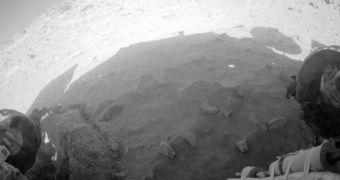According to officials at the American space agency, the Martian Exploration Rover (MER) Spirit may have today become the most enduring mission on Mars ever. Yesterday, the machine reached the 6 years and 116 days mark of the Viking-1 lander, which was thus far considered to be the longest-running mission on the Red Planet. Still, validating the record is a bit tricky, given that Spirit has entered a hibernation mode that is meant to ensure it can survive its fourth Martian winter. If the robot wakes up in the spring, then it would become the clear record holder, Space reports.
Spirit is followed closely by its twin MER, Opportunity, which arrived on Mars some 21 days after it, on January 25, 2004. If Spirit for some reason doesn't wake up in the spring, then Opportunity will pick up the record. Until the stuck rover signals home, its sister robot will most likely become the record holder, even if until spring. Engineers at the NASA Jet Propulsion Laboratory (JPL) in Pasadena, California, who manage the two MER components, say that they have no serious reasons for concern that Spirit won't make it this year as well.
“When Spirit comes out of hibernation, she can claim Viking 1's record for longest-lived surface mission. Opportunity, still driving, hopes to break the Viking 1 record too,” NASA officials write on the MER Twitter page. Both explorations robots are currently in the middle of their seventh year on Mars, after they were deployed there for a routine, six-month-long trek. Both of them managed to endure the harsh conditions they encountered, though arguably Opportunity had it a lot easier. Because it's located closer to the Equator than Spirit, it benefits from more sunlight, and therefore doesn't need to hibernate during the winter.
This is also visible in the distance the machines drove since arriving at their respective destination. While Opportunity drove 12.4 miles (20 kilometers), Spirit only moved forward about 4.8 miles (7.7 kilometers) before embedding itself in a patch of loose Martian soil, now called Troy. The incident took place at the end of April, 2009, and JPL engineers tried in vain to untangle the robot from its predicament. With winter on its way, they decided to rename the rover into a stationary science platform, and decided that Troy will be its final resting place.
“A communication from Spirit on April 29 or later would be a confirmation that it has matched or exceeded VL1's longevity. That might not happen before Opportunity reaches the VL1 longevity mark, which will be on May 20,” JPL spokesman Guy Webster said recently. “By lasting such a long time, the rovers have been able to accomplish far more science and exploration than we ever expected, and that's a wonderful thing. We're very proud of that,” added MER principal investigator Steve Squyres, who is based at the Cornell University, in Ithaca, New York.

 14 DAY TRIAL //
14 DAY TRIAL //